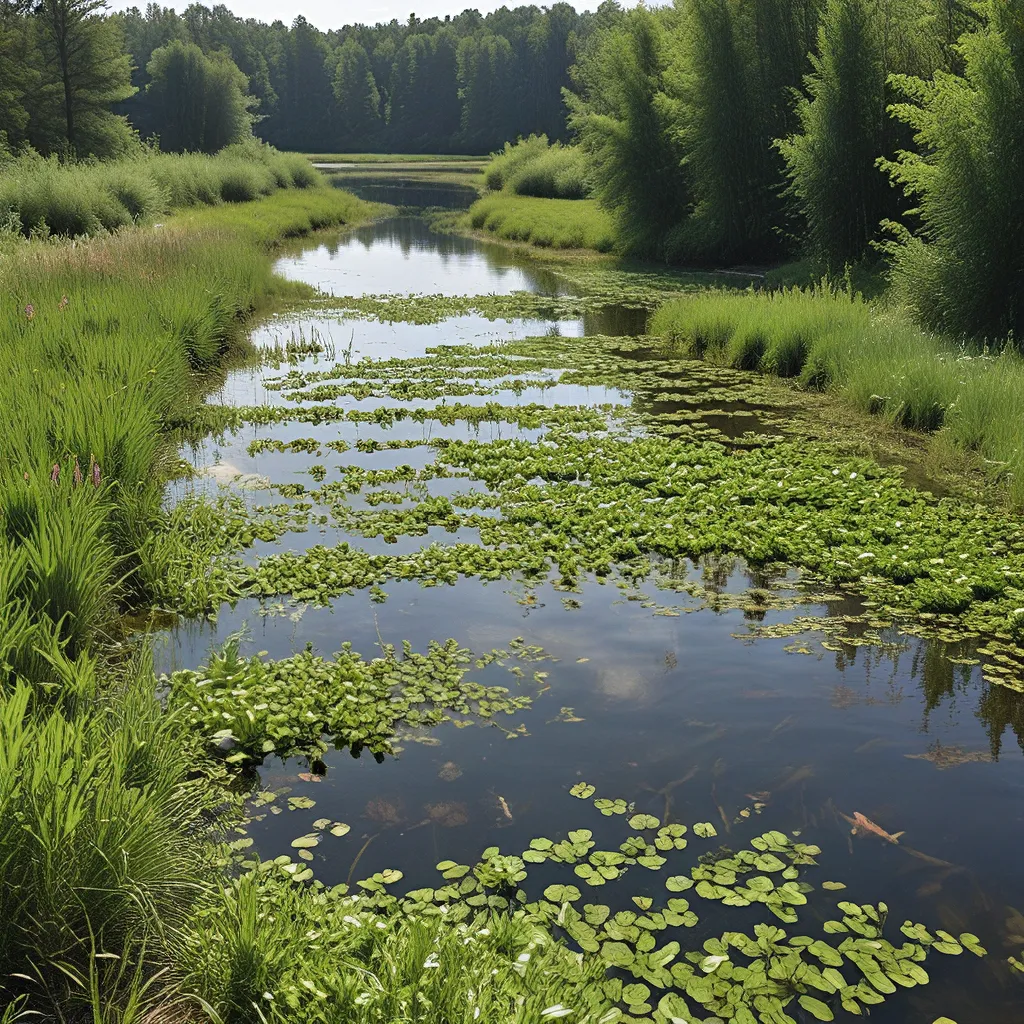
As an environmental enthusiast, I’ve always been fascinated by the ingenious ways nature can be harnessed to tackle some of our most pressing challenges. And when it comes to wastewater treatment, one of the most promising solutions lies in the realm of phytoremediation – the use of aquatic plants to remove, degrade, or immobilize contaminants from water.
Imagine this: Instead of relying solely on energy-intensive mechanical systems, we can enlist the help of Mother Nature’s own water purifiers – plants that thrive in aquatic environments and possess the remarkable ability to absorb, transform, and even degrade a wide range of pollutants. It’s a fascinating concept that’s been gaining traction in the world of sustainable water management.
The Aquatic Plant Superheroes
Let’s dive into the world of these aquatic plant superheroes and explore how they can be used to revolutionize the way we treat our wastewater. From the floating water hyacinth to the submerged duckweed, these unassuming plants possess a hidden power that can make a big difference in our water quality.
Water hyacinth, for instance, is known for its rapid growth and remarkable ability to absorb heavy metals, such as lead, cadmium, and mercury, as well as other pollutants like nutrients, pesticides, and even oil spills. Imagine these vibrant, floating plants literally cleaning up our waterways – it’s like something straight out of a sci-fi movie!
But water hyacinth is just the tip of the phytoremediation iceberg. Duckweed, a tiny, fast-growing aquatic plant, has also caught the attention of researchers for its potential in wastewater treatment. These diminutive plants can efficiently remove nitrogen and phosphorus from water, helping to combat the problem of eutrophication, which can lead to the formation of harmful algal blooms.
The Phytoremediation Process: A Natural Filtration System
The beauty of phytoremediation lies in its simplicity and efficiency. Unlike conventional wastewater treatment methods that rely on energy-intensive mechanical processes, phytoremediation harnesses the natural abilities of aquatic plants to clean and purify water.
The process works like this: The plants absorb the pollutants through their roots, stems, and leaves, effectively removing them from the water. Once absorbed, the contaminants can be broken down, transformed, or even stored within the plant’s tissues. In some cases, the plants can even release enzymes that help to degrade the pollutants, further enhancing the purification process.
But the benefits of phytoremediation don’t stop there. As the plants grow and thrive, they can also help to improve the overall ecosystem of the water body, providing habitat for a variety of aquatic life and supporting the natural balance of the environment.
Exploring the Versatility of Phytoremediation
The applications of phytoremediation are far-reaching, and researchers are continuously exploring new ways to harness the power of aquatic plants to tackle a diverse range of water pollution challenges.
One exciting area of study is the use of constructed wetlands – engineered systems that mimic natural wetland ecosystems to treat wastewater. These wetlands are designed to incorporate a variety of aquatic plants, each with their own unique capabilities, to create a self-sustaining filtration system. By strategically combining different plant species, these constructed wetlands can effectively remove everything from heavy metals to pharmaceutical residues from the water.
Another intriguing application is the use of floating treatment wetlands, where aquatic plants are grown on a buoyant platform that can be deployed in rivers, lakes, or even reservoirs. These floating systems not only remove pollutants but also provide valuable habitat for wildlife, creating a win-win situation for both the environment and the community.
Phytoremediation and the Future of Wastewater Treatment
As we look to the future, the potential of phytoremediation in wastewater treatment is truly exciting. With ongoing research and advancements, we may soon see these natural, plant-based systems becoming an integral part of our water management strategies.
Imagine a world where wastewater treatment facilities seamlessly incorporate aquatic plants, reducing their reliance on energy-intensive processes and creating a more sustainable, eco-friendly approach to water purification. Or picture lush, floating wetlands dotting our urban waterways, not only cleaning the water but also providing valuable habitats and recreational spaces for our communities.
The possibilities are endless, and the promise of phytoremediation lies in its ability to harness the power of nature to solve some of our most pressing environmental challenges. As we continue to explore and refine this innovative approach, I can’t help but feel a growing sense of optimism about the future of water management.
So, the next time you see a water hyacinth or a patch of duckweed, remember that these unassuming plants are part of a revolution in sustainable wastewater treatment. They’re not just pretty faces – they’re the champions of a cleaner, greener future.
Alpha Wastewater is at the forefront of this exciting transformation, exploring the power of phytoremediation and other innovative solutions to address the complex challenges of wastewater management. By embracing the natural abilities of aquatic plants, we can work towards a future where water is not only cleaner but also more abundant and accessible for all.